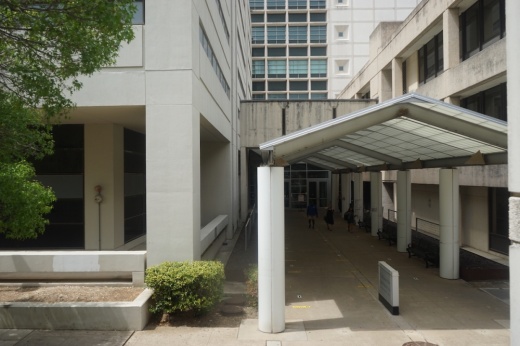Over the past couple years, Staley’s Royal Blue Grocery stores in downtown Austin have become a target for shoplifting and break-ins. Staley noticed serving jail time was not deterring shoplifters as many of them seemed to be experiencing homelessness, mental illness or a substance use disorder.
“What we have seen in some of our stores [are] these repeat offenders,” Staley said. “They’ll get arrested for breaking into a store or shoplifting. And we’ll track them in Travis County [Jail], and then we’ll see that they got out, and they’ll return to our store.”
When Staley reached out to Travis County Judge Andy Brown about the issue last fall, the county’s Forensic Mental Health Project—a 10-month study to identify solutions to the county’s growing mental illness problem—was already in full swing.
The study, which was completed in March, led to a recommendation to build a diversion center that will bring nonviolent offenders to a facility with mental health services instead of jail or an emergency room.
The center—an estimated $30 million endeavor that will take at least two years to build—was met with widespread support from local government and the community, including law enforcement, Austin City Council, homeless advocacy groups and legal experts. It was also a promising step forward for Staley.
Both Staley and Brown said the county jail effectively functions as the areas largest mental health facility. Staley said he also sees many individuals struggling on the streets.
“And, of course, neither one of those are doing anything for these individuals that really need our help.”
The need for care
As of April 18, the Travis County Jail population had reached almost 2,200 inmates, up from the early stages of the pandemic, when the population was in the 1,400s, Brown said. About 40% of the county’s jail population self-reported having a mental illness, up from about 21% in 2020.
Brown said if a quarter of that population were eligible for the diversion program, it would relieve pressure from corrections officers as the department is down about a third of its staff with 263 vacancies as of March.
With a growing number of inmates with mental health issues, Texas’ limited resources for care are backed up. About 150 Travis County Jail inmates are waiting for competency restoration—a process in which a defendant with a mental health disorder is given legal education so they can understand their trial. One of these inmates has been waiting for over 420 days, according to Dell Medical School at the University of Texas at Austin.
With a diversion center, eligible individuals would not have to receive competency restoration in the first place: Those arrested for nonviolent crimes would not have to stand trial if they complete the diversion program and have their records expunged.
Further, a report compiled by Dr. Stephen Strakowski, a professor at The University of Texas Dell Medical School, and other members of the Forensic Mental Health Project identified that out of a sample of 2,231 arrested individuals, 106 both self-reported mental illness and cycled through jail system at least three times. One individual had been arrested 89 times.
Of the crimes committed by this group, 75% were misdemeanors, and over half of those were criminal trespassing.
“As law enforcement, our capacity to really affect [mental health] has been affected by our inability to do anything other than to take people to jail,” Austin Police Department Chief Joseph Chacon said.Signs of success
The diversion center will not be the county’s first effort to redirect those accused of a nonviolent crime from jail. The Sobering Center has provided intoxicated individuals a safe place to detox since it opened in August 2018, according to county documents.
Further, mental health diversion centers in similarly populated cities have shown signs of success. Nashville’s center led to a 70% drop in repeated offenses since it opened in 2020, according to the report.
A diversion program for those charged with second- or third-degree felonies in Miami-Dade County led to 68% fewer jail bookings and 94% fewer jail days for participants compared to those who did not participate in the program, according to the report.
Taxpayer impact
The mental health diversion center will cost about $30 million to build and between $2.5 million-$5 million annually to operate. The center will likely be funded through a variety of sources including federal, state, city and county dollars, Central Health---the county’s health care district---and some private sources of funding. Austin City Council approved a motion to work with the county to find financial sources and provide program recommendations April 13.
Diversion efforts have saved taxpayers dollars in other cities, such as the Miami-Dade crisis intervention program, which diverted enough arrests between 2010-18 that the county was able to close one of its jails, saving an estimated $12 million in taxpayers dollars annually, according to the report.
Long road ahead
The diversion center is just one component of a five-part plan to reform the county’s jail system. To effectively address mental illness in the county, technology upgrades, bridge support housing programs and increased peer support services will need to be in place, according to the report. The county will also need to reinstate the counsel-at-first-appearance program, which was active for 13 days last spring and then canceled due to staffing shortages.
“If it is done in isolation, nothing will change; it will just back up and be another jail,” Strakowski said.
If the county successfully implements all five components, it will still need to fully staff the center, which has historically been a struggle for both city and county law enforcement.
Quiana Fisher, the homelessness response system strategy director for the Ending Community Homelessness Coalition, added that to be effective, the diversion center will need staff who can adequately provide mental health resources to people experiencing homelessness and Black residents as Black people have historically been underserved in mental health systems.
“We have to do this with the service providers that have proven to best serve the most impacted and that we’re doing that with a racial equity lens and challenging some of the assumptions that all of our systems make in surveying the Black communities,” Fisher said.
A safer county
When people with mental illness receive treatment instead of jail time, it creates safety for family members and the community as a whole, said Terra Tucker, the Texas director for the Alliance for Safety and Justice—a public safety solution organization—and steering committee member.
“Breaking cycles of crime and doing prevention are things that actually make us safe, right? So we’re not just being reactionary to what’s already happened, but preventing new things from happening,” Tucker said.
Strakowski said diversion programs also create safety for people with mental illness as they are often subject to violence and assault themselves.
“We have an obligation to care for our citizens who can’t care for themselves,” Strakowski said. “And we are failing in that.”





